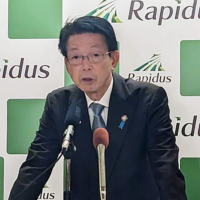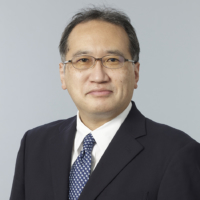Japan is facing a structural labor shortage due to population decline and thus needs to utilize digital technologies such as generative artificial intelligence and robots across all industries to maintain people’s standard of living and enhance productivity and industrial competitiveness. Moreover, generative AI is expected to contribute to the creation of innovative products and services.

However, Japan lags behind other countries in its scale of digital investment and the digital deficit is expanding. It is critical for us to establish robust development and utilization platforms for generative AI domestically. Competitiveness in generative AI relies not only on computational processing capabilities, but also on low power consumption to curb electricity demand. To achieve these aspects simultaneously, it is urgent to create an ecosystem in which hardware (such as semiconductors and data centers) and software (such as AI programs) function smoothly together.
Semiconductors are a technology critical for achieving digitalization and decarbonization. Furthermore, from the standpoint of economic security, they are strategic materials that influence Japan’s overall industrial competitiveness, and it is essential for Japan to capture the significantly increasing global demand for these products. Particularly with the emergence and rapid advancement of generative AI, the presence or absence of a robust industrial base for advanced, next-generation microchips will greatly impact the overall competitiveness of industries.
Governments around the world are taking large-scale measures to secure chip manufacturing capacity. Likewise, the Japanese government has been swiftly implementing legal reforms and considerable financial support to aid the semiconductor industry. Over the past three fiscal years, it has secured a budget of about ¥4 trillion (roughly $26 billion).
Based on this budget, construction of the first facility of Japan Advanced Semiconductor Manufacturing, a joint venture in Kumamoto between Taiwan Semiconductor Manufacturing Co. and several Japanese companies the government decided to support two years ago, is progressing at an astonishing pace. It is expected to begin shipping by the end of the year, with a second facility set to break ground soon.
The Rapidus project, which aims to mass produce next-generation logic semiconductors, is also progressing smoothly with research and development, and preparations are steadily advancing toward mass production in 2027, including the opening of a business office on the West Coast of the United States this spring.
As a result of these various kinds of support for the industry, significant spillover effects are already beginning to appear. For example, a private estimate suggests the JASM projects are expected to increase employee compensation by ¥380,000 per capita annually in Kumamoto Prefecture.
Additionally, the growth rate of investment in facilities in Kyushu reached an all-time high last fiscal year, and there is a positive cycle of investment and wage increases, with numerous investment projects being announced and executed, including those by small- and medium-sized enterprises. The semiconductor industry is expected to serve as a catalyst for the revitalization of many of Japan’s industries. Moreover, since semiconductor production facilities are often built in regional areas, they contribute to the regional revitalization promoted by the administration of Prime Minister Shigeru Ishiba.
Therefore, the government has decided to implement a policy to induce investment with heightened predictability rather than use sequential policy input to develop the AI and semiconductor sectors. Specifically, it aims to support technology development and capital investment plans for AI and semiconductors over the next seven years until fiscal 2030, triggering over ¥50 trillion in public and private investment over the next 10 years, and to achieve an economic ripple effect of approximately ¥160 trillion associated with semiconductor production and other activities.
Since this requires enhancing the predictability of private-sector entities and ensuring necessary funding across multiple years, the government decided to provide over ¥10 trillion in public support through subsidies, commissions, financial assistance and legal measures under the AI and Semiconductor Industry Base Strengthening Framework. As part of this framework, we will develop domestic production bases and support research and development for advanced and next-generation semiconductors, consider legal measures needed to mass produce next-generation semiconductors, and submit draft legislation to the next ordinary Diet session.
Based on such a financial framework, we will continue to support research and development and funding procurement for mass production of next-generation chips, support design and development of application-specific integrated circuits, also known as ASICs, for the generative AI era, and support capital investment and research and development for advanced and conventional semiconductors and their components.
Japan’s semiconductor policy is at a critical juncture. We will continue to make every effort to revive it and to subsequently promote and utilize the AI industry starting from there, strengthening the international competitiveness of the entire Japanese economy and ensuring economic security through the resilience of supply chains.





